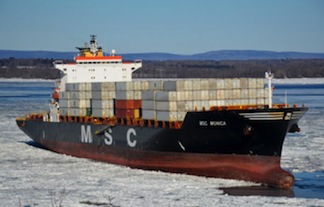The following is the text of a news release from the Transportation Safety Board of Canada (TSB):
(QUEBEC CITY) — In its investigation report released on May 29, the Transportation Safety Board of Canada found that ambiguous communications between the pilots and bridge crew, and incorrectly installed emergency backup steering controls, led to the January 2016 grounding of the container vessel MSC Monica in Deschaillons-sur-Saint-Laurent, Quebec.
On Jan. 22, 2016, MSC Monica was on a voyage from Montreal, Quebec, to Saint John, New Brunswick, with a helmsman, the officer of the watch, and two pilots on the bridge. The vessel ran aground in the St. Lawrence River 1 nautical mile north-northeast of Deschaillons-sur-Saint-Laurent, Quebec. It was refloated the following day with the assistance of three tugs, and proceeded to Quebec City to undergo the necessary inspections. The vessel sustained minor damage to its hull and major damage to the propeller. There were no injuries or pollution reported.
The investigation found that MSC Monica unexpectedly veered to starboard, likely due to the helm being inadvertently placed to starboard. The subsequent communication between the helmsman and the pilot navigating the vessel was ambiguous, which led the pilots and the officer of the watch to conclude that there was a steering gear failure. The second pilot then switched to the backup steering system. However, its control was not installed consistently with international standards or with the manufacturer's specifications. The second pilot, who was unfamiliar with this particular installation, unintentionally applied a hard turn to starboard rather than a hard turn to port while attempting to maintain the vessel in the buoyed navigation channel. A delayed hard-to-port course correction was applied by the officer of the watch; however, the vessel eventually ran aground. Post-occurrence examinations revealed no malfunction with the vessel's steering gear system.
The investigation also determined that the installation of the backup steering control (non-follow-up, or NFU mode) was such that it would contradict a user's expectations. If the ergonomics of critical shipboard equipment are designed in a way that is confusing or contradicts expectations, there is a risk that a user who is unfamiliar with their configuration will operate them incorrectly. Furthermore, it was found that there is a risk of premature, uncoordinated and ineffective actions if bridge team members do not share a complete and common understanding of a problem and continuously exchange information to solve problems.
Following the occurrence, the backup steering control was correctly reinstalled in accordance with the manufacturer's recommendations. Although no steering malfunction was identified, the owners of MSC Monica preventively overhauled several steering gear system components and replaced various control and navigation equipment on the bridge during the periodic dry-docking of the vessel, which took place in Turkey during the fall of 2016.
Click here to read the complete report.

